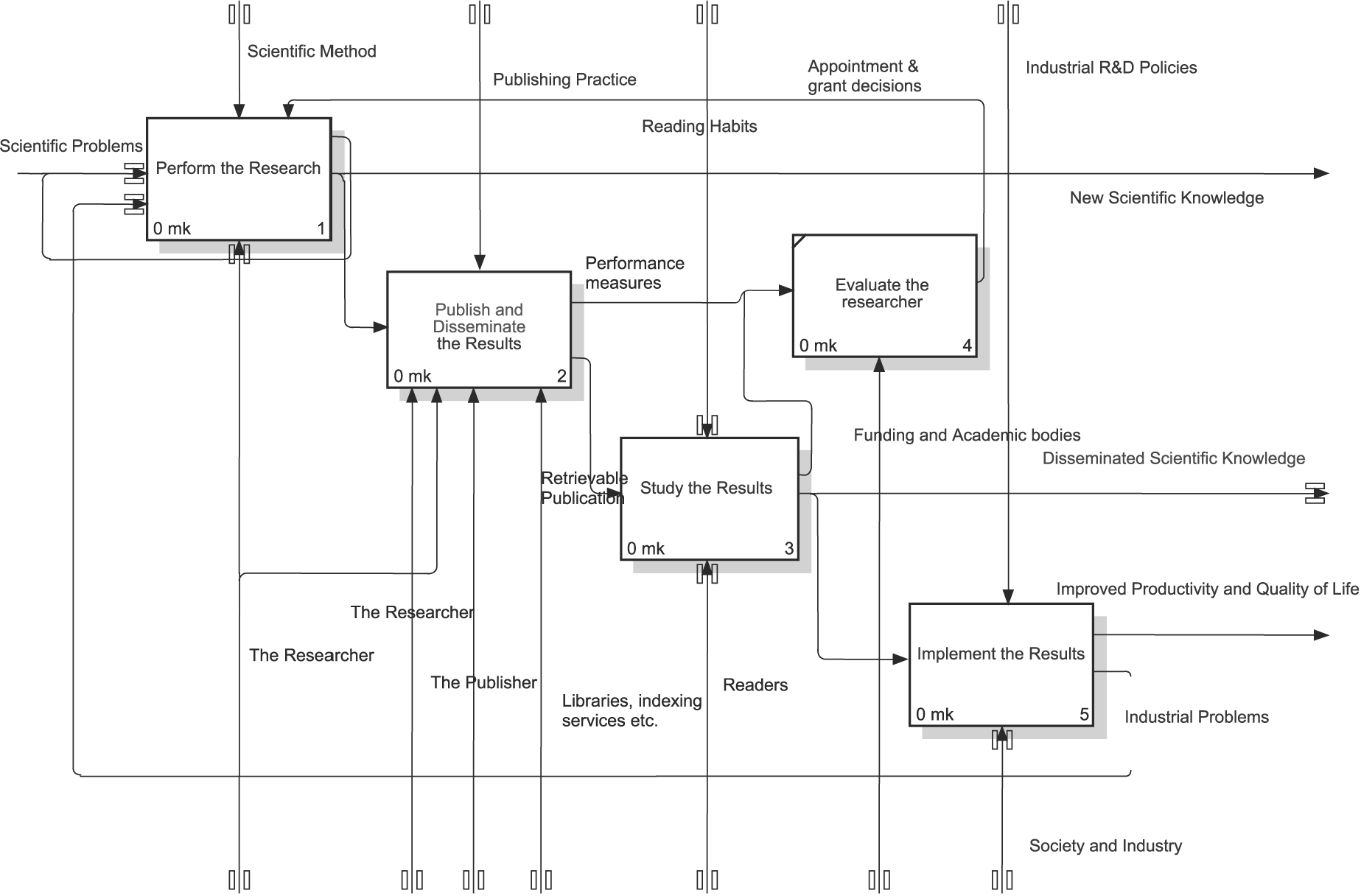Academic writing
This article or section is currently under construction
In principle, someone is working on it and there should be a better version in a not so distant future.
If you want to modify this page, please discuss it with the person working on it (see the "history")
This piece will attempt to provide an overview of various issues related to academic writing.
A process model of the scientific publishing life-cycle
According to Brörk and Hedlund (2004) and (2002), the stakeholders include:
- researchers who perform the research and write the publications;
- publishers who manage and carry out the actual publication process;
- academics who participate in the process as editors and reviewers;
- libraries that archive the publications and provide access to them;
- bibliographic services which facilitate the identification and retrieval of publications;
- readers who search for, retrieve and read publications; and
- practitioners who implement the research results directly or indirectly.
According to Björk et al. (2003), one can model the do research, publish and implement the results life-cycle with the following diagram:

A revised model was presented by Björk (2007)

Teaching academic writing
“Although models have been a mainstay of academic writing pedagogy for centuries, a recurrent critique has been that they control or limit student writing and misrepresent the affairs they claim to model. These insufficiencies notwithstanding, models are ubiquitous in the ordinary, practical world, and their usefulness to novices can easily go unnoticed by experts.” (MacBeth, 2009:1).
“Model texts, skeletal or otherwise, do offer the promise that if one follows them an ideal outcome will result. Leki (1995) found in her case studies of university-level English language learners that looking for such models and examples was a common coping strategy used by the students to survive the writing demands of their disciplinary courses [...] The shortcoming of such models or sample texts may well be their strongest recommendation to novices. They offer formal, generic representations of social practices that are far from generic or formally structured. They convey these practices not only as formal and structured, but stable, reliable, and vividly so. Yet other tasks and occasions will defeat the model's assurances, as the students later discover. These “false provisions” have something to do with the familiar critique of models as a curricular design. The criticisms are longstanding and foreshorten our interest in and appreciation for the work models do. In light of the materials presented here, we can see how the model text achieved what a pedagogy for novices must achieve: it must be vivid, evident, stable, and show its “parts.” But it achieves this accessibility for novices through the false representation of the social practices and conventions it represents.” (MacBeth, 2009:13).
Links
Bibliography
- Belcher, D. and A. Hirvela, (1995). (Eds) Academic writing in a second language: Essays on research and pedagogy, Ablex, Norwood, NJ.
- Brodkey, L. (1987) Academic writing as social practice, Temple University Press, Philadelphia (1987).
- Björk, Bo-Christer and Turid Hedlund, (2004). A formalised model of the scientific publication process, Online Information Review, 28 (1). PDF - Abstract/HTML/PDF.
- Björk, Bo-Christer; Turid Hedlund, Jonas Holmström, and John Cox, (2003). D2: Scientific Publishing: To-Be Business and Information Model, SciX (Open, self organising repository for scientific information exchange) PDF, retrieved 13:40, 22 October 2009 (UTC).
- Björk, B-C. (2007). "A model of scientific communication as a global distributed information system" Information Research, 12(2) paper 307. [Available at http://InformationR.net/ir/12-2/paper307.html], retrieved 13:40, 22 October 2009 (UTC).
- Macbeth, Karen P. (2009). Deliberate false provisions: The use and usefulness of models in learning academic writing, Journal of Second Language Writing, In Press, Corrected Proof, Available online 15 October 2009, ISSN 1060-3743, DOI: 10.1016/j.jslw.2009.08.002
- Hyland, K. (2004) Disciplinary discourses: Social interactions in academic writing, University of Michigan Press, Ann Arbor (2004).
- Leki, I. (2007) Undergraduates in a second language: Challenges and complexities of academic literacy development, Erlbaum, Mahwah, NJ (2007).
- Dores, Robert M. ; Ian W. Henderson, Autoplagiarism, citation rating, and skulduggery, General and Comparative Endocrinology, Volume 140, Issue 2, 15 January 2005, Page 85, ISSN 0016-6480, DOI:10.1016/j.ygcen.2004.12.001
- Macbeth, K. (2006). Diverse, unforeseen, and quaint difficulties: The sensible responses of novices learning to follow instructions in academic writing, Research in the Teaching of English 41 (2006), pp. 180–197.
- Shih, M. (1986). Content-based approaches to teaching academic writing, TESOL Quarterly 20 (1986), pp. 617–648. PDF
- Swales, J. and C. Feak, (2004). Academic writing for graduate students: Essential tasks and skills (2nd Ed.), University of Michigan Press, Ann Arbor (2004).
Move to Open contents
- Björk, B.-C. (2003), "Towards open access to scientific publications – which are the barriers to change", paper presented at the DigiLib2003 Conference: Towards a User-Centred Approach to Digital Libraries, National Library of Finland, Espoo, September
- Odlyzko, A. (1998), "The economics of electronic journals", Journal of Electronic Publishing, http://www.press.umich.edu/jep/04-01/odlyzko.html, Vol. 4 No.1, .
- Gueédon, J.C. (2001), ``In Oldenburg's long shadow: librarians, research scientists, publishers, and the
control of scientific publishing, ARL Proceedings 138, Association of Research Libraries, Washington DC, http://www.arl.org/resources/pubs/mmproceedings/